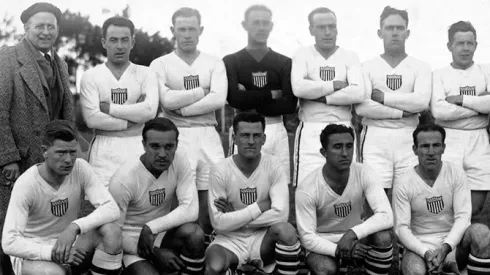
James “Jimmy” Brown, the oldest boy of eight children, was born in Kilmarnock, Scotland on December 31, 1908 and raised in Troon. Growing up back then, next to Royal Troon Golf Club, it offered boys the choice of either playing golf or soccer. James never played organized soccer but was part of a group of kids who played on the streets of Troon and enjoyed sneaking on Royal Troon’s course to play a quick nine holes with his brothers before sunset.
After completing a five-year riveting apprenticeship at the Troon Shipyard, he took off for America in late 1927 to find his father. James Sr., was a veteran WWI balloonist, who had left the family a number of years earlier because of alcohol problems to settle down in Westfield, New Jersey where he had family. He reunited with his father but they never reconciled. Nevertheless, his father’s brother took him in and while working in a metal box factory in Plainfield, New Jersey, he got a look at his first American soccer game in May 1928 and his first official team called the Plainfield Soccer Club, scoring four goals in his first match. Then he played with the Bayonne Rovers of Harrison before the start of the summer months, scoring a goal in each of the eight matches he played. Overall for both teams, he scored 13 goals in two months.
Within a year, he signed first with the Newark Skeeters and then top flight NY Giants in late 1929. During his year with NY Giants, he scored 19 goals in 51 games. During his American career, he scored over 61 goals in four years.
He formed a powerhouse tandem with Davey Brown (no relation). They were known as the Brown Bombers. Davey was one of the league’s leading scorers of his time. As 1930 came around, the U.S.F.A was the first federation to accept FIFA’s invitation to the first soccer football World Championships, to be held in Montevideo, Uruguay. James was born in Scotland and therefore Scottish, but because his father had been naturalized as a US citizen, James automatically qualified for US citizenship.
After battling through the US East Coast trials in which he scored two goals, James made his way onto the US squad, a remarkable feat given that he had only played organized soccer for a couple of years. He was tall, well built and could “run like a deer,” as James always said later on in life. During the 1930 World Cup against Belgium, James “made a beautiful run down the right wing, drawing out Belgium’s keeper and delivered an unselfish lob over the his head to Bert Patenaude who headed into an empty goal,” recounted US Manager W.R. Cummings.
Cummings went on to say it was one of the most brilliant plays in the entire tournament. They blanked Belgium and Paraguay with identical scores of 3-0. James scored the only goal in the semi-final showdown against Argentina, losing 6-1. During that game, his teammates suffered severe (eventual career-ending) knee injuries and knocked out teeth. James always said the refereeing was atrocious and the Argentine defenders were spitting at him and throwing dirt in his face. His goal in the semifinal made him the first and only Scotsman or American to have scored in a FIFA World Cup semi-final.
On the way back home to the US from South America after the World Cup, it was rumored that James was in negotiations with Glasgow Rangers, Everton, and Newcastle but those rumors were unfounded. After the World Cup and post exhibition matches in Brazil and Argentina where he scored one goal, James stayed in the US playing with the NY Soccer Club (formerly the NY Giants), Brooklyn Wanderers and Newark until August of 1932 at which time he decided to return to the United Kingdom, where he signed with Manchester United.
An interesting Manchester United historical note is that Secretary-Manager Scott Duncan hired a tugboat to take him out to the ocean liner, Caledonia, in order to beat all the other managers waiting on the dock to try to sign James. As clever as he was, Duncan was surprised to see that the Partick Thistle manager Donald Turner was already heading into the purser’s room with James. Turner had surely been tipped off by his former captain, Alex Lambie, James’s uncle. So Duncan burst into the room, grabbed James and hurried him into the chief steward’s room. A while later, James, Duncan and a freshly signed contract with the Red Devils came down the gangway to the surprise of all the waiting managers including Heart’s William McCartney.
There was much-to-do about the signing circumstances of the “ginger- haired” lad from America. In his first match at Old Trafford against Grimsby, James scored directly from a corner kick, despite the wind blowing away from the goal (the ball reportedly made a 90 degree turn into the goal). He would recount later in interviews that it was a specialty that he perfected in his off time, in all types of weather: heavy winds away and against the goal, rain, sleet or snow back in New York.
Alf “Casual” Clark, the columnist for the Manchester Evening Chronicle, wrote that there was an old chant from the crowd that bellowed ”Give it to Joe,”referring to a past United player named “Joe” who had a particular talent. And he thought it might be soon be re-baptized, ”Give it to Jim” because he had never seen fans at Old Trafford get so excited for the next corner kick.
He scored ten goals in 25 first team appearances during the 1932/1933 season – the second highest goalscorer at the club. At the end of the 1933/1934 season, James had made 16 appearances and scored seven goals for the first team – again the second highest goalscorer. Before James was transferred for not having “settled down,” he did manage on May 6, 1934 during the Manchester Cup Final with United’s reserves to bring home the Senior Cup (Manchester Derby) by beating Manchester City 1-0 at Old Trafford in front of a crowd of 5,000. Jimmy scored the lone goal in the second half.
One of the major reasons he floated between the first team and reserves was the fact that he voiced his opinion about players’ rights and that wasn’t looked upon kindly by management.
That same union activism plagued him throughout his time with Brentford and Tottenham Hotspur although he was a prolific goal scorer and a solid contributor for the reserves side at both clubs. At Brentford, he scored 53 goals in 74 matches. At Tottenham, he scored 21 goals in 34 matches.
It wasn’t until he went to Guildford City FC that he finally settled down and found a home, hammering in goals and dealing out assists. He played with one of the most impressive and talented group of men coming from the non-league. Many thought they were better than most third Division sides before World War II. With Guildford, he scored a record high 148 goals in 150 games, including seven goals in one game, of which six were with his head. Both records still stand today at Guildford City.
He’s the first Scot/American to have played for both Manchester United and Spurs’ first teams. During his career in Great Britain, he scored over 209 goals.
Other US players who went to Manchester United
Eddie McIlvenny, the US captain in the historic 1950 World Cup win against England, signed an on-the-spot contract with the legendary Matt Busby. Eddie played between 1950-1953, making two first team appearances but scored no goals. US goalkeeper Tim Howard played for Manchester United between 2003-2007, making 77 appearances, and Jonathan Spector made eight appearances between 2003-2006.
An interesting note – Walter Bahr, the 1950 World Cup US squad member and ASL All-Star, played against Manchester United in the 1950 US tour. Matt Busby offered Walter a contract as well on the spot but Walter declined it because it was less than he was making as a Philadelphia school teacher.
A family united in soccer
After World War II stopped his, and many other promising soccer careers in their tracks, James went back to riveting at the Troon shipyard alongside his brothers, Tom, the goalkeeper for Ipswich Town and John, Clyde’s famed goalkeeper who stopped everything in his path during their 4-0 defeat of Motherwell in the 1939 F.A. Cup. As part of the war effort, the brothers were exempt because of their contributions at the shipyard. A while later, James caught wind that workers down the road were making twice what they were so he convinced his brothers, known at the shipyard as the “Bell Squad,” to go on strike.
Well, that didn’t sit too well with the management, especially their foreman and uncle, Tam Bell. He threatened to tear up their exemption status if they didn’t get back to work. When they didn’t budge, that’s what he did; he tore their exemptions forcing Tom and John to enlist: Tom as a commando, parachuting into China to help the resistance and John in the merchant navy. The irony here is that James, the one who convinced them to strike, wasn’t eligible to enter the war because of a busted eardrum during his years as a riveter. His brothers never let him hear the end of that whole incident and luckily came out of the war unscathed.
After the war, and especially after the loss of his first born son, James, while still a young lad, moved back to the United States in 1948 with his wife Mary and their two other children, George and Margaret. There he revived the Connecticut Soccer League and formed soccer team Greenport United so that he could play/coach with George, who was now in his teens.
After a few years playing, he finally hung up his boots and focused on coaching both as a manager for the Elizabeth Polish Falcons (where George played) but also at Brunswick Academy as the varsity soccer and riflery coach. As George got older and turned pro, James, Mary, and Margaret rarely missed one of his games, whether it was for the NY German-Hungarians (three consecutive league titles; the 1956 New York State Cup; 1953 GASL league MVP and All-Star); Elizabeth Polish Falcons (leading league goalscorer and All Star) and US National team or 1959 bronze medalist for the US Pan American Team.
Throughout their careers and afterward, James and George were heavily involved in local soccer programs providing guidance or helping revive the sport in various communities. They helped create interest in soccer where no one thought it was possible. Both of them were inducted into the U.S. National Soccer Hall of Fame. They are the only father/son in the player category. George also served as interim president of the Soccer Hall of Fame.
Just to show you how passionate the Brown family is about soccer, even George’s wife Margaret Brown worked at the National Soccer Hall of Fame as the archive manager cataloging US soccer history.
Editor’s note: Writer James Brown is the grandson of James Brown, and son of George Brown (who is alive and well in West Deptford, New Jersey). The author, who is writing a book on the Brown and Lambie family sporting history, can be reached at robyburns@hotmail.com. James Brown is interested in speaking with family members of the 1930 US World Cup squad to exchange stories and memorabilia.













